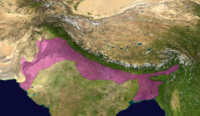
Photo from wikipedia
Abstract When the Cimmerian Continent separated from Gondwana and drifted northward to equatorial latitudes, sedimentary rocks on the continent underwent intense weathering, resulting in the formation of bauxite deposits. Gheshlagh… Click to show full abstract
Abstract When the Cimmerian Continent separated from Gondwana and drifted northward to equatorial latitudes, sedimentary rocks on the continent underwent intense weathering, resulting in the formation of bauxite deposits. Gheshlagh is one such bauxite deposit, located in the Alborz Mountains in northern Iran. The bauxite deposit at Gheshlagh, 12–18 m in thickness with a strike length > 4 km, is hosted by Permian strata and unconformably overlain by Early Triassic limestone. Detrital zircon grains in the bauxite deposit yielded U Pb ages ranging from 2.5 Ga to 0.5 Ga, with most ages between ca. 0.9 Ga and 0.5 Ga. The detrital zircon grains with age populations between ca. 0.9 Ga and 0.6 Ga are tabular and rounded with sharp oscillatory zoning, and most likely derived from igneous rocks in the northern part of the Arabian-Nubian Shield. The detrital zircon grains with ages of ~1 Ga are long and rounded in shape with slightly obscure growth zoning and probably originated from metamorphic rocks of the Sinai basement in the northernmost part of the shield. Detrital zircon with ages between 1.8 and 2.5 Ga are smoothly rounded in shape with faint internal zoning, suggesting long transport from a metamorphosed source(s), possibly including the Saharan Metacraton, and/or the Kabul Block. The Gheshlagh deposit contains minor needle-like to prismatic-shaped zircon grains, with U Pb ages ranging from ca. 571 to 521 Ma, corresponding to the timing of the Cadomian magmatic event in northern Gondwana. The occurrence of such proximal sourced zircons at Gheshlagh supports the notion that northern Gondwana was an active margin in response to southward subduction of Prototethys during late Neoproterozoic to Early Cambrian. Our data also suggest that the Cimmerian Continent was still located on the northern margin of Gondwana during deposition of the bauxite protolith in the Permian.
Journal Title: Gondwana Research
Year Published: 2021
Link to full text (if available)
Share on Social Media: Sign Up to like & get
recommendations!